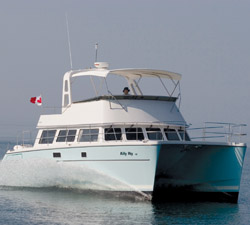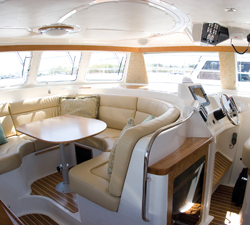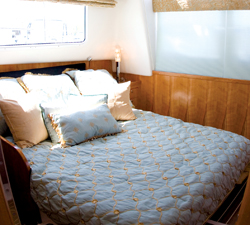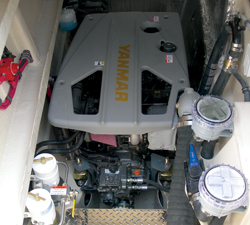PDQ 41
 While this yacht may not have been designed to suite every taste, long range cruisers and live-aboard couples have taken to the PDQ 41 Power Catamaran with enthusiasm. This Canadian-made cat hails from the Whitby area in Ontario but PDQ cats have found loving homes in harbours around the world.
While this yacht may not have been designed to suite every taste, long range cruisers and live-aboard couples have taken to the PDQ 41 Power Catamaran with enthusiasm. This Canadian-made cat hails from the Whitby area in Ontario but PDQ cats have found loving homes in harbours around the world.
PDQ Yachts was established in 1987 To build sailing catamarans and their very well established 44 Antares model has been a major success but in 2001 The company created their first power cat; the 34.
The 34 continues but now, several successful years later, PDQ Yachts has introduced the 41 Power Catamaran and it is quite a remarkable vessel indeed. The boat is priced and sold in fully equipped form at $650,000 US and in our opinion, that is a comparative bargain.
From tip to tail, this cat is 41 feet but like Garfield, it’s a beamy brute. Measuring 18 feet wide, the PDQ 41 compares in beam to yachts in the 50 to 60 foot range. Then, from the PDQ sailing heritage comes a dedication to light weight, even when that demands more expensive materials. The PDQ 41 is in the vicinity of 26,800 lbs. That is light for this much space.
 The quick overview is that it is a two stateroom yacht with two heads, spacious saloon, standard lower helm and upper station on a very impressive flying bridge, has a very useable forward deck, great side decks and a usefully large aft cockpit, while all of this is powered at a very economical level by twin Yanmar diesel engines yet the PDQ 41 can rush from a standing start to a top speed near 30 mph in about 20 seconds. It is quite a package.
The quick overview is that it is a two stateroom yacht with two heads, spacious saloon, standard lower helm and upper station on a very impressive flying bridge, has a very useable forward deck, great side decks and a usefully large aft cockpit, while all of this is powered at a very economical level by twin Yanmar diesel engines yet the PDQ 41 can rush from a standing start to a top speed near 30 mph in about 20 seconds. It is quite a package.
You will generally board from the stern and port and starboard side steps up the hulls are molded in. There is a boarding ladder on the port side. The cockpit is fairly spacious and sheltered from the wind when underway so this will be an enjoyable place to catch some sun. Because the catamaran hulls are very widely spaced, there’s lots of room in between for bringing a dinghy up on davits. Hatches open for access to the engine rooms and you can step right down into each hull for owner maintenance purposes. Getting at the sides of the engines is a bit of a trick but with familiarity, these will be more friendly engine rooms than you find in many similar priced mono-hull boats.
 The side decks are very wide [although actually not as wide as on the PDQ 34] and there are very well-placed deck rails all around, with lifelines and hand rails surrounding the cabin trunk as well. PDQ gives you several opening gates in the railing so that you can step onboard from the dock or pier in any one of several different positions; you are not limited to boarding at the stern.
The side decks are very wide [although actually not as wide as on the PDQ 34] and there are very well-placed deck rails all around, with lifelines and hand rails surrounding the cabin trunk as well. PDQ gives you several opening gates in the railing so that you can step onboard from the dock or pier in any one of several different positions; you are not limited to boarding at the stern.
The forward deck has an impressive anchor layout with electric windlass, an immense anchor locker and the 41 can be rigged to carry two anchors, should that better suit your cruising needs. Another good feature is that the boat can be equipped with a stern anchor and PDQ has provided space for installing a stern windlass. Large horn cleats with fairleads are located at the corners and spring positions.
There are storage lockers in the forward decks that simply swallow even very large fenders with ease.
It is up a few steps up to the flying bridge and because of the beam, this bridge compares to what you get in the 50 foot range, and the catamaran design has the stability and load capacity to carry a big crowd up top. On the bridge is a port  side upper galley and refreshment unit including stainless steel sink, Isotherm refrigerator, Vitrifrigo icemaker, Force 10 BBQ with neat propane tank storage nearby.
side upper galley and refreshment unit including stainless steel sink, Isotherm refrigerator, Vitrifrigo icemaker, Force 10 BBQ with neat propane tank storage nearby.
The bridge has a venturi wind deflector around the forward edge to protect those in the Pompanette helm and companion seats. These are adjustable, swivel and have fold up armrests. Aft is a wraparound seat with loads of storage under and a removable table. The size is impressive and yet we wished for a smaller (or different design) table to make it easier to get in and out and we would substitute a fish-boat style flip back helm seat would make this great area even better.
Another neat feature is that the radar arch can be lowered hydraulically for bridge clearance and the arch works well with the Bimini top.
The bridge helm has two sets of analog instruments for the Yanmar 260 hp diesel engines as well as the digital readout with selectable functions and our test boat was equipped with a Raymarine E120 system, Horizon VHF radio and a fixed steering wheel, although we were able to get quite comfortable in the adjustable seat with the molded in footrest.
 Incidentally, we liked the dot pattern nonskid that PDQ used. It seemed to work well and looked like it would be easy to clean. Another exterior item to note was the companionway storage and convenient access to the battery switches.
Incidentally, we liked the dot pattern nonskid that PDQ used. It seemed to work well and looked like it would be easy to clean. Another exterior item to note was the companionway storage and convenient access to the battery switches.
A substantial aluminum cabin door with window, roll-out screen and friction damper to prevent slamming, leads into the cabin.
PDQ includes a complete lower helm as standard. It is ideal on long trips, in cold, rainy or hot weather (thanks to the three zone A/C). A nice feature is that you can see behind as well as ahead thanks to a clever opening panel in the bulkhead that lets the captain look through the large glass areas of the master stateroom [more on that later]. We could conveniently see from about three o’clock to eight o’clock — ideal for docking even in inclement weather.
The ship’s electrical panel and system controls are to the portside. There is a shelf where most owners will mount a television and the cabinet top is a large chart table, convenient to the interior helm. The stereo CD and satellite audio system is overhead in a pod.
PDQ finishes their 41 Power Catamaran with a Teak and Holly sole throughout the interior. It is warm and attractive.
Dominating the cabin is the enormous center mounted C-shaped dinette. This is a great area for entertaining. A hi /lo table converts from dinning into an enormous playpen or guest berth. There are five different storage areas underneath the benches and more storage on the starboard side, although it’s only really accessible from the dinette seats.
PDQ mounts the galley down four steps in the portside hull and there is a Eurocera propane stovetop with three burners, LG convection microwave, two substantial stainless steel sinks with a pullout faucet, a very handy side rail for glasses storage, a Nova Kool 9 cubic foot two-door refrigerator freezer, four drawers and twelve different lockers plus 3 underfloor access panels, which could also hide a few flat items. This galley delivers amazing space. Two could both work there comfortably.
The guest, or day head is in the portside hull, at the forward end and you access it by walking through the galley. This has two lockers, an MSD, stainless steel sink, hand-held shower, screened opening portholes and a small overhead hatch.
Then at the aft end of the port hull is the guest cabin. Although the berth is high and tight to the sides, it feels relatively spacious and has a double size mattress, screened hatch and portholes, standing height and two cedar lined lockers.
There’s a big surprise when you open the locker under the berth! You will find a Splendide Combomatic washer / dryer, and it is standard.
We’ve kind of saved the best for the last. Something long-range cruising couples will love is that the spacious master stateroom is on the upper deck level; no more sleeping in the “basement” of the boat. This stateroom is bright and airy with huge glass areas, two that open and it feels like a bedroom at home. Night tables, a large storage area under the mattress and then down the starboard side hull four steps is a hanging locker, several deep lockers in the sides, six drawers and nine side lockers in varying sizes.
Ahead of that is the master head with stainless steel sink, MSD, medicine cabinet with a mirror, fully enclosed shower stall and two opening portholes as well as a deck hatch all with a screens.
So, the accommodations are remarkable but how does this all go? Performance is a key feature in this type of hull design. The 41 never “planes off” the way a vee hull does as speeds rise above about 18 mph. This boat stays level and simply moves forward faster and faster – to 29.2 mph at 3,900 in the relatively loaded test boat. Tight turns at speed cause the 41 to lean out a bit the way a car does but the weight transfer is subtle and it carves a tight radius.
Tracking is impressively accurate and the helm requires little attention. Best cruise seems to be around 17 mph and the Yanmar 260’s are doing an astonishing 8 gph. You almost never hear the Yanmars at work either. They are far away and isolated even from the cabin – almost silent on the bridge.
Sadly, flat calm water prevented us from commenting on rough weather capabilities but that is the cat’s forte – this is a boat designed for ocean travel, yet it will cruise rivers and canals with ease compared to many other designs.
There’s no doubt about it, the catamaran hull layout in this size range can be developed to offer simply remarkable accommodations considering the boat’s length and price tag. In addition to that, the fuel efficiency and the long-range capabilities make the PDQ 41 Power Catamaran, a made in Canada solution for cruising in paradise.
By Andy Adams
To see if this boat is available, go to www.boatcan.com to check listings!























